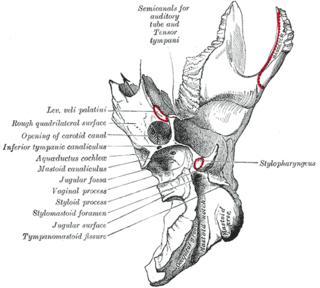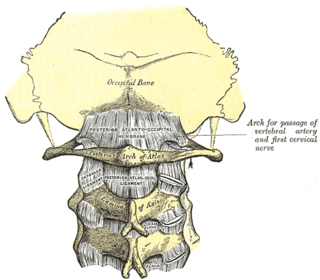Articles related to anatomy include:

The subarachnoid cisterns are spaces formed by openings in the subarachnoid space, an anatomic space in the meninges of the brain. The space is situated between the two meninges, the arachnoid mater and the pia mater. These cisterns are filled with cerebrospinal fluid (CSF).

The posterior inferior cerebellar artery (PICA) is the largest branch of the vertebral artery. It is one of the three main arteries that supply blood to the cerebellum, a part of the brain. Blockage of the posterior inferior cerebellar artery can result in a type of stroke called lateral medullary syndrome.

The cerebellopontine angle (CPA) is located between the cerebellum and the pons. The cerebellopontine angle is the site of the cerebellopontine angle cistern.

The musculus uvulae is a bilaterally muscle of the soft palate that acts to shorten the uvula when both muscles contract. It forms most of the mass of the uvula. It is innervated by the pharyngeal plexus of vagus nerve.

The tympanic canaliculus is a minute canal in the bony wedge/ridge that separates the carotid canal and jugular foramen/jugular fossa. The proximal opening of the canal is situated upon the inferior surface of the petrous part of the temporal bone; its distal opening is situated upon the floor of the tympanic cavity. The canal gives passage to the tympanic nerve i.e. tympanic branch of glossopharyngeal nerve ), and inferior tympanic artery.

The posterior atlantooccipital membrane is a broad but thin membrane extending between the to the posterior margin of the foramen magnum above, and posterior arch of atlas below. It forms the floor of the suboccipital triangle.

The pontine cistern is a subarachnoid cistern situated ventrally/anteriorly to the pons. It contains the basilar artery. Each lateral aperture opens into the pontine cistern just posterior to the cranial nerve VIII.

The interpeduncular cistern is the subarachnoid cistern situated between the dorsum sellae (anteriorly) and the two cerebral peduncles of the mesencephalon (midbrain). Its roof is represented by the floor of the third ventricle. Its floor is formed by the arachnoid membrane extending between the temporal lobes of either side. Anteriorly, it extends to the optic chiasm.
The chiasmatic cistern or suprasellar cistern is a small subarachnoid cistern related to the optic chiasm.
The cistern of lateral cerebral fossa is an elongated subarachnoid cistern formed by arachnoid mater bridging the lateral sulcus between the frontal, temporal, and parietal opercula. The cistern contains the middle cerebral artery (MCA) and its branches, and the two middle cerebral veins (MCVs).
The quadrigeminal cistern is a subarachnoid cistern situated between splenium of corpus callosum, and the superior surface of the cerebellum. It contains a part of the great cerebral vein, the posterior cerebral artery, quadrigeminal artery, glossopharyngeal nerve, and the pineal gland.
The ambient cistern is a bilaterally paired subarachnoid cistern situated at either lateral aspect of the mesencephalon (midbrain). Each ambient cistern has a supratentorial compartment and an infratentorial compartment. Each is continuous anteriorly with the interpeduncular cistern, and posteriorly with the quadrigeminal cistern.

The following outline is provided as an overview of and topical guide to human anatomy:
The cerebellopontine cistern is a paired subarachnoid cistern at the cerebellopontine angle, an angle created between the cerebellum and the pons on either side. Each cerebellopontine cistern is continuous anteromedially with the pontine cistern.
The marginal sinus is a dural venous sinus surrounding the margin of the foramen magnum inside the skull, accommodated by the groove for marginal sinus. It usually drains into either the sigmoid sinus, or the jugular bulb. It communicates with the basilar venous plexus anteriorly, and the occipital sinus posteriorly ; it may form extracranial communications with the internal vertebral venous plexuses, or deep cervical veins.

The thyrohyoid branch (also: thyrohyoid branch of ansa cervicalis, or nerve to thyrohyoid (muscle)) is a motor branch derived from the cervical plexus formed by fibres of (the anterior ramus of) the cervical spinal nerve 1 (C1) (and - according to some sources - cervical spinal nerve 2 (C2) as well) that join and travel with the hypoglossal nerve (cranial nerve XII) to reach the suprahyoid region, branching away from CN XII distal to the superior root of ansa cervicalis (which is a branching other fibres of C1-C2 that had traveled with the CN XII), near the posterior border of the hyoglossus muscle. The thyrohyoid branch of ansa cervicalis innervates the thyrohyoid muscle.

The posterior superior nasal nerves are branches of the maxillary nerve that arise in the pterygopalatine fossa and pass through the sphenopalatine foramen into the nasal cavity to innervate the nasal septum, and the posterosuperior portion of the lateral wall of the nasal cavity.

The arcuate eminence is a rounded prominence upon the superior surface of the petrous part of the temporal bone forming the lateral part of the posterior wall of the middle cranial fossa. The arcuate eminence indicates the position of the underlying superior semicircular canal.










